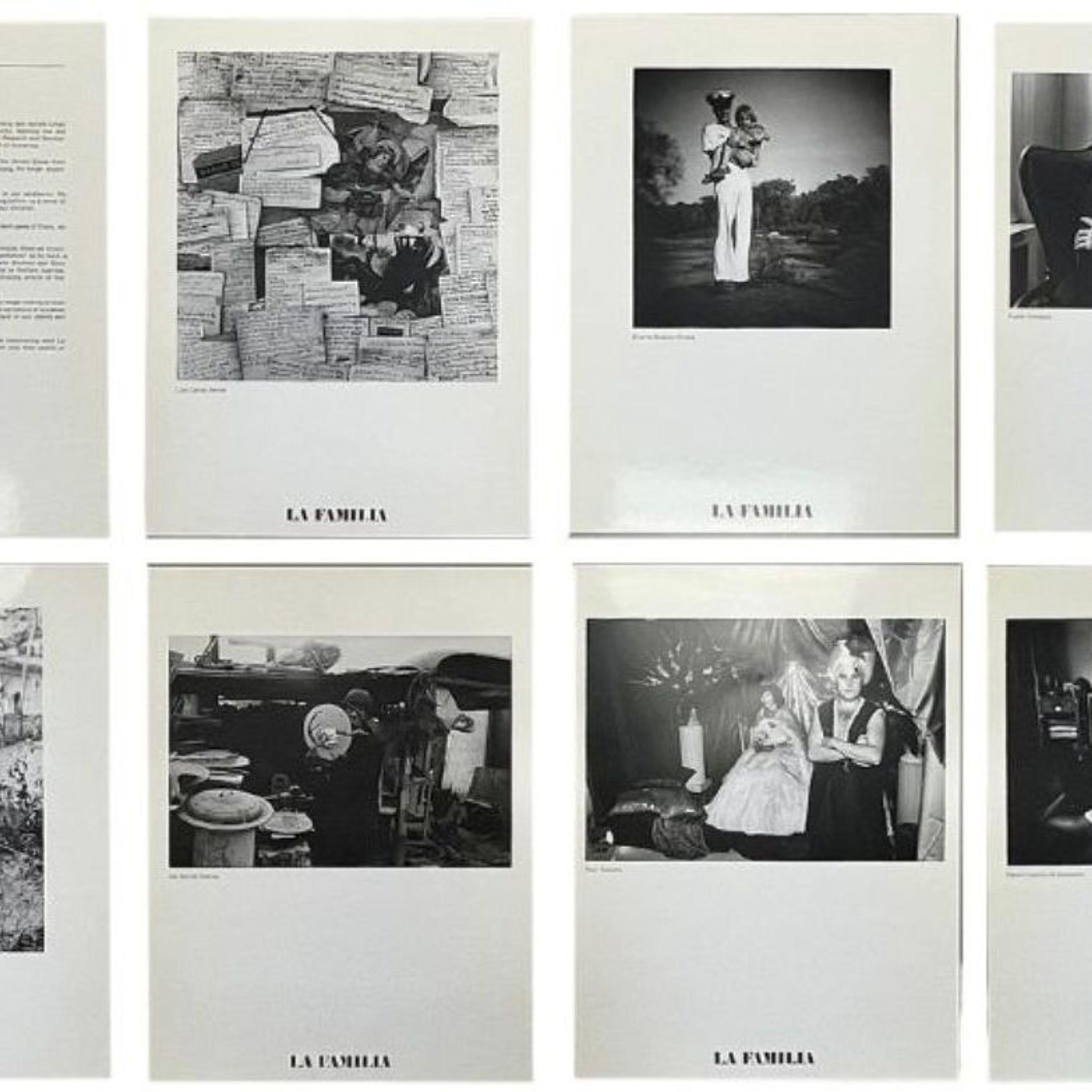Over the last ten months working as a Research Associate and Bibliographer for the NEH collection expansion grant project, I have researched over one thousand artists and helped Watson Library identify and acquire over seven hundred titles by or about Latinx and Hispanic American artists. As a transplant who moved to New York City to study early modern Spanish art, I was ignorant of the rich history of contemporary Latin American artists who have made New York their home. As we have researched, purchased, unboxed, and cataloged new titles for Watson Library, I have learned more about how much this thriving artistic community has championed the preservation and enrichment of the many cultural heritages that make up the broader Latinx and Hispanic American population of this city. And how, in their organizing and publications, they have altered the course of contemporary art in the United States.
I wanted to ensure that Watson Library could serve as a repository for the publications of the workshops, collectives, and alternative spaces that form the rich and deep artistic and cultural communities immediately surrounding The Met. As important as it is to amass titles pertaining to individual artists, it is also crucial to tell the history of collecting, practice, and collective organizing. Acquiring publications by and about these groups allows for artists not otherwise highlighted by major exhibitions but featured in group shows, artist workshops, and community advocacy to be included in future discourse and research.

Alternative Histories: New York Art Spaces, 1960 to 2010, edited by Lauren Rosati and Mary Anne Staniszewski (Cambridge, Massachusetts: MIT Press, 2012)
During the 1960s and 1970s, a robust community of diverse artists emerged from US-born artists of Latin American and/or Caribbean heritage, expatriates lured to the States by educational opportunities, and others who sought refuge, living in exile away from their native homes. With New York as their central hub, artists from across the Americas and the Caribbean came together to work collaboratively to further the causes of equity, representation, and community building. Cries for social justice and critiques of capitalist consumerism inspired artists to break away from tradition and embrace conceptual, experimental, performance, and installation-based art. This challenge to the old way of making and showcasing art required alternative spaces and artist-run collaborations that fit their specific goals and ambitions as well as their unique cultural perspectives.
The New York Graphic Workshop (NYGW)
Founded in 1964 by three young Latin American artists—Luis Camnitzer (Uruguay), José Guillermo Castillo (Venezuela), and Liliana Porter (Argentina)—the NYGW was a cooperative space that brought together professional printmakers from all backgrounds to share ideas, create and display their work, and experiment together. Porter and Camnitzer met while attending Pratt Graphic Art Center in Manhattan and felt that highbrow academic art didn’t serve their individual experiences as Latin American printmakers. As revealed in their original manifesto, they believed that “the work [of printmaking] is enriched by the diversity of materials that can be used” and thus sought to incorporate alternative printing techniques as well as new means of exhibiting their work. Their goal was to create work that was “conditioned but not destroyed by [their] techniques.”
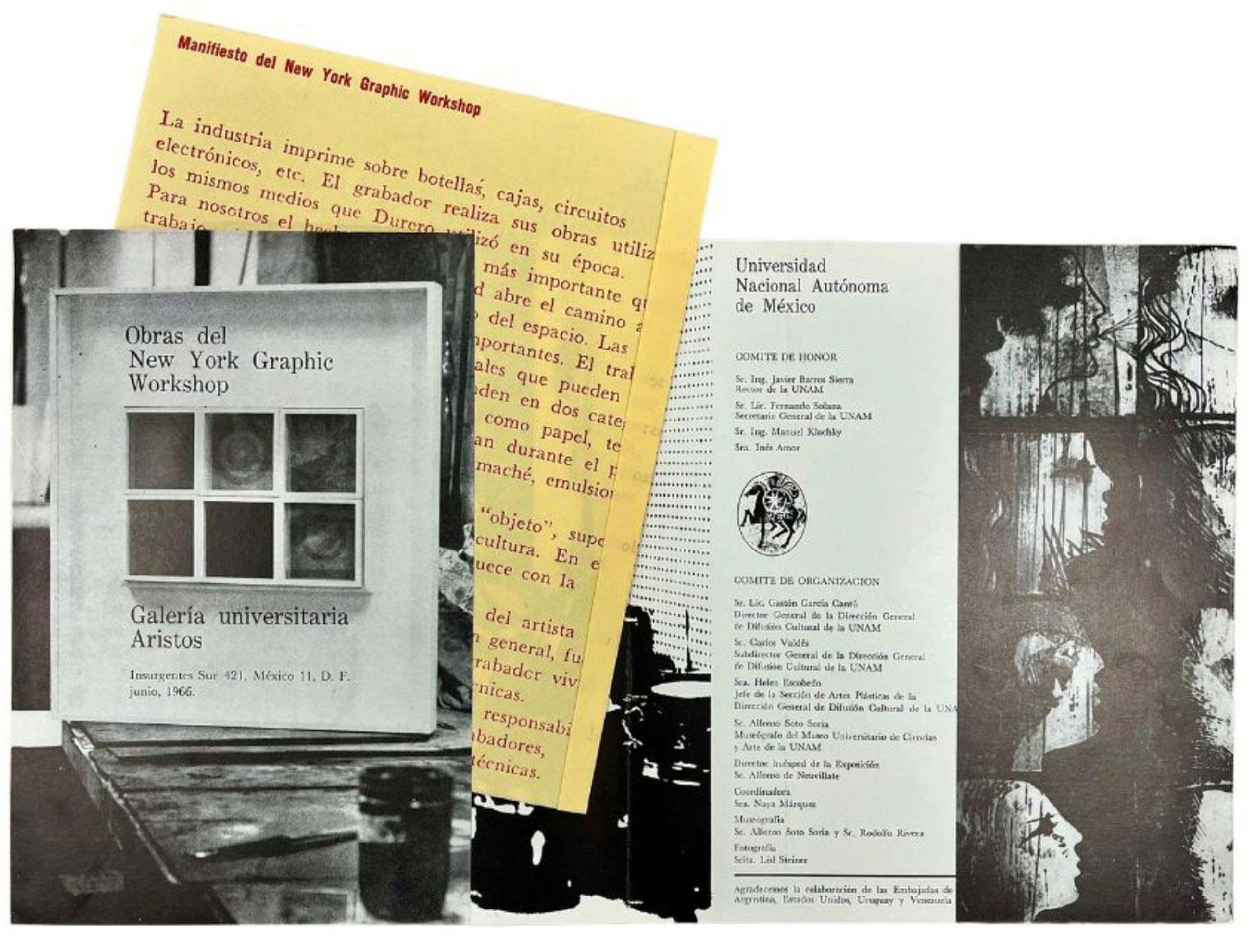
Obras del New York Graphic Workshop (Mexico, D.F.: Galería Universitaria Artístos, 1966)
The organization of the NYGW marked a significant moment in the history of conceptual art in New York, and while they remained centered here, they quickly grew to exhibit in galleries and museums across the Americas. Camnitzer recalls, “We were sensitive to the pressures of New York…but we had also brought the periphery with us and we maintained our Latin American perspectives and commitments.”

The New York Graphic Workshop, 1964-1970, edited by Gabriel Pérez-Barreiro, Ursula Davila-Villa, Gina McDaniel Tarver (Austin, Texas: Blanton Museum of Art, the University of Texas at Austin, 2009)
El Museo del Barrio
In the same era, the Puerto Rican presence in New York city had reached a peak, and arts groups worked with community advocates to transform the cityscape in enduring ways. In 1969, when a group of African American and Puerto Rican parents, educators, and community activists in Central and East Harlem demanded that the School Board provide education that reflected the diverse cultural heritages of the people of their neighborhood, Rafael Montañez Ortiz was appointed to create a cultural enrichment program on Puerto Rican history, culture, folklore, and art. The result was El Museo del Barrio, the oldest museum dedicated to Latinx art in the United States. Today, the mission of El Museo is consistent with these origins, as they seek to present and preserve the art and culture of Puerto Ricans and all Latin Americans in the United States through their collections, exhibitions, publications, bilingual public programs, and educational activities. Their permanent collection ranges from pre-Hispanic Taino objects to twenty-first century time-based media works and their ongoing program of exhibitions, lectures, educational events, and festivals remains a vital part of cultural life in El Barrio.

Selected catalogs from El Museo. (Top, from left to right): Jorge Soto Sánchez: Works on Paper, 1974-1979 (1979); Arte [no es] Vida: Actions by Artists of the Americas 1960–2000 (2008); Estamos Bien: La Trienal 20/21 (2021); Retro/active: The Works of Rafael Ferrer (2010); Gods, Spirits and Legends: 20th Century Art from El Salvador (1998). (Bottom, from left to right): The Voyager (1981); El Museo's 5th Bienal, 007 (2007); Edgar Franceschi: In Dreams Begin Responsibilities: A Survey of Work, 1980–1988 (1988); Behind the Veil of a Myth: Belkis Ayón (2018); A Photo Essay: Precolombiana Hasta 1940 (1975)
Through the NEH project, Watson has been able to amass the Museo del Barrio titles missing from our collection including early works, such as the 1975 exhibition catalog A Photo Essay: Precolombiana Hasta 1940, and more recent volumes, like Estamos Bien, the publication from the postponed 2020 Triennial which took place from March to September of 2021.

(Top) A Photo Essay: Precolombiana Hasta 1940 (New York: El Museo del Barrio, 1975). (Bottom) Estamos Bien: La Trienal 20/21 (New York: El Museo del Barrio, 2021)
Taller Boricua
While many alternative art spaces founded during this period claimed territory downtown—where enclaves of artists settled—Taller Boricua made East Harlem its home. Founded in 1969 by Nuyorican artists Marcos Dimas, Adrian Garcia, Manuel “Neco” Otero, Martin Rubio, and Armando Soto, it operated as an artist-run studio that worked in close collaboration with El Museo to serve El Barrio. Dissatisfied with the problems their community faced—namely inadequate housing, healthcare, and education—they stood at the forefront of the fight for representation and better living conditions.
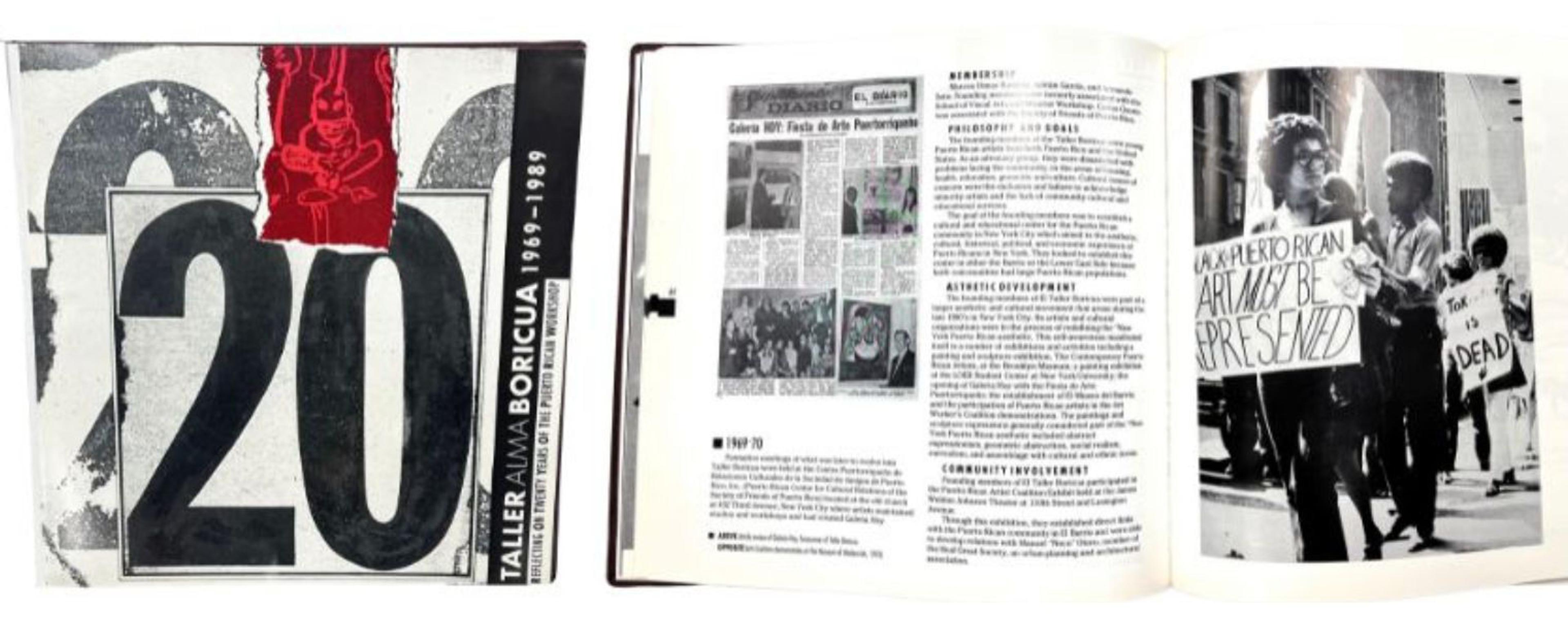
A photo of members of the Arts Coalition protesting outside of the Museum of Modern Art in 1970, advocating for the representation of Puerto Rican artists. Taller Alma Boricua, 1969–1989: Reflecting on Twenty Years of the Puerto Rican Workshop (New York: El Museo del Barrio, 1990)
In 1970, they incorporated as a non-profit arts organization under the name the Puerto Rican Workshop, Inc. and participated in the wider cultural movement of the age to define a “New York Puerto Rican aesthetic” that featured artists working in abstraction, social realism, surrealism, and assemblage. Their mission to "establish a cultural and educational center for the Puerto Rican community in New York City and enhance the aesthetic, cultural, historical, political, and economic experience of Puerto Ricans in New York” has now expanded to highlight marginalized artists from all backgrounds who remain underrepresented and underserved by dominant cultural spaces.

Two catalogs from exhibitions at Taller Boricua. (Left) Karen Marston: Respirations (New York: Taller Boricua Gallery, 2005) was curated by Taller founder, Marcos Dimas; (Right) Miguel Trelles, Chino Latino: Xiao Zhong Xian Da (Puerto Rico: [publisher not identified], 2002)
En Foco Inc.
Amidst the civil rights movement, a group of three Puerto Rican photographers were frustrated by the lack of input Latinos held in crafting their own image. Concerned that the portrayal of Latinos in popular media and fine art in the United States was too often negative and one-dimensional, Charles Biasiny-Rivera, Phil Dante, and Roger Cabán got together in 1974 to form En Foco Inc., a non-profit organization working to exhibit, workshop, and provide funding pathways for American photographers of Latinx, African, and Asian heritage, and native peoples of the Americas and the Pacific.
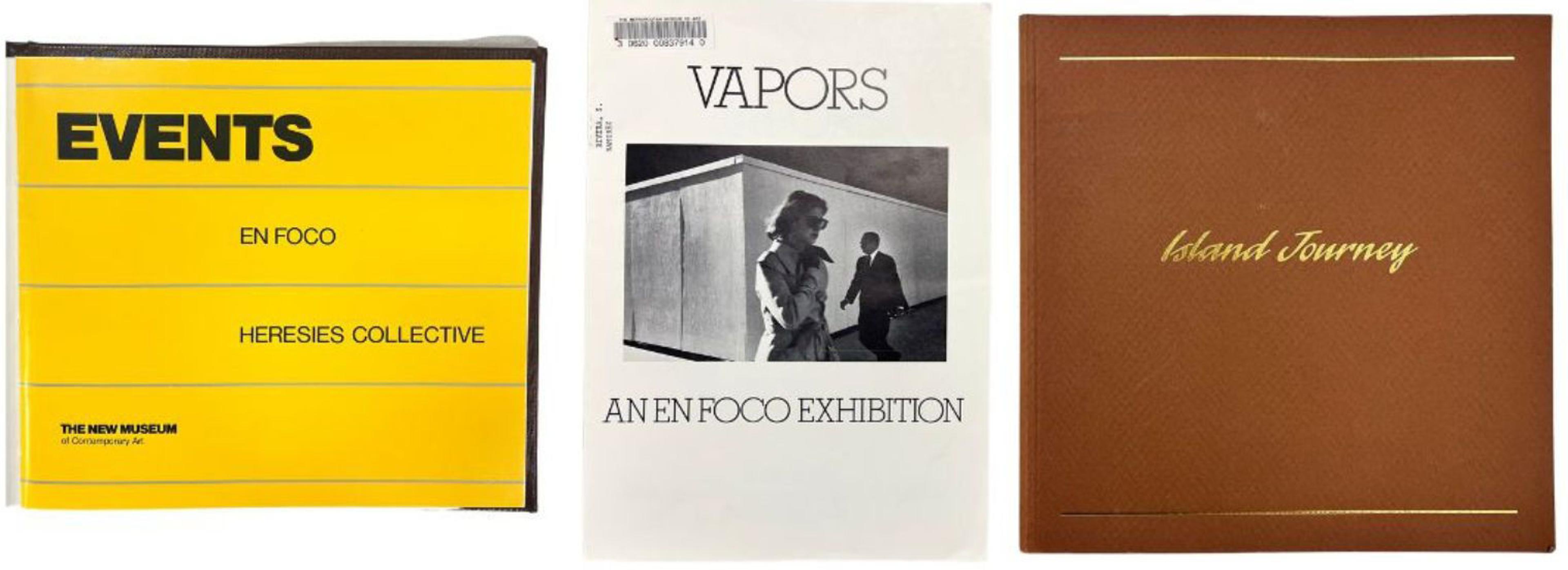
A selection of catalogs from En Foco Inc. (Left) Events: En Foco, Heresies Collective (New York: New Museum of Contemporary Art, 1983); (Center) Vapors: An En Foco Exhibition (Bronx, New York: En Foco, 1980); (Right) Island Journey: An Exhibition of Puerto Rican Photography (Bronx, New York: Hostos Art Gallery, 1995)
En Foco promotes cultural equity through photographic exhibitions and publications that educate the public. Their journal, Nueva Luz: A Photographic Journal, was launched in 1985 to address issues in photography facing artists of color. While many physical copies of the journal can be consulted in person at Watson, the entire run of the publication can be consulted on its digital archive.
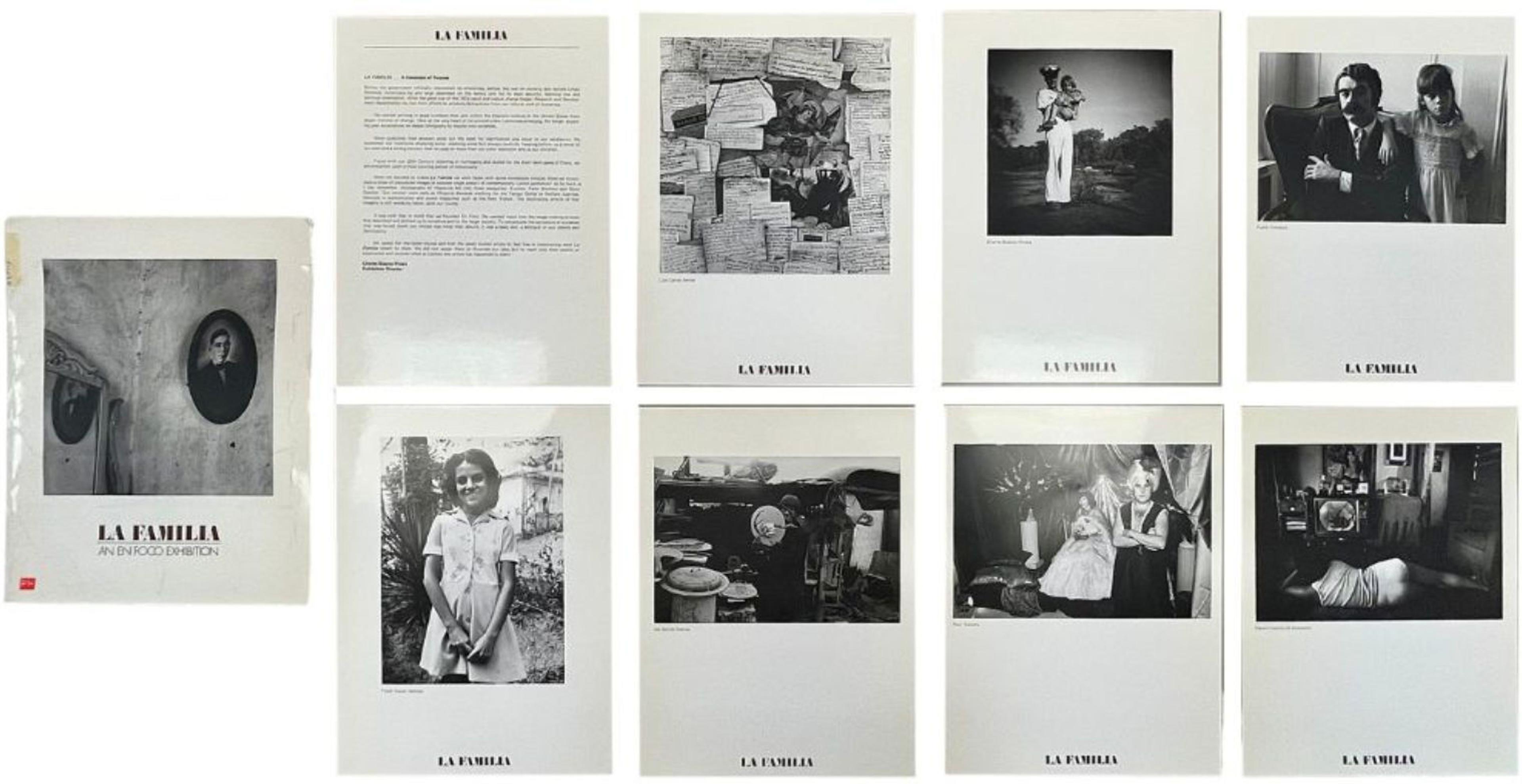
Portfolio catalog from La Familia: An En Foco Exhibition (Bronx, New York: En Foco Press, 1979). Featuring work by (top, left to right) Luis Carlos Bernal, Charles Biasiny-Rivera, Frank Gimpaya, (bottom, left to right) Frank Xavier Méndez, Jose Bernal Ramos, Raul Rubiera, and Naomi Castillo de Simonetti
Just as the four organizations highlighted in this post were born out of a strong pulse of Latinx and Hispanic American communities of their time, and many of them continue to be cultural leaders in the city, there are now emerging and growing collectives carrying on their legacy. The New Latinx Art Collective, El Taller Latino Americano (The Latin American Workshop), the Neo-Latino Collective (based in New Jersey), The LatinX Project at NYU, Colectiva Cosmica, Precog Magazine, among others, point to the future. Watson Library looks forward to collecting publications from these historically crucial and emerging groups alike in order to become a repository for resources about important art-based cultural organizing in New York City.

First four issues of Precog Magazine, recently acquired for the NEH project (from left to right, volumes 1–4)
In addition, this post marks the launch of the Latinx and Hispanic American Artist Index. Similar to the Index of African American Artists published in 2021 and the Index of Asian American and Pacific Islander Artists published earlier this year, this resource includes over seven hundred names of artists whose works are currently represented in Watson’s growing collection. With this limitation in scope, we acknowledge that this index cannot and should not be considered an authoritative or comprehensive record of American artists of Latin American and Hispanic heritage. However, we hope that this resource will serve future scholarship as well as public interest. This index will expand over time as we continue our acquisition endeavors and make regular updates. Later this fall, as our yearlong project ends, a research guide will also become available. Until then, please be sure to follow our Instagram page (@metlibrary) for project updates.
